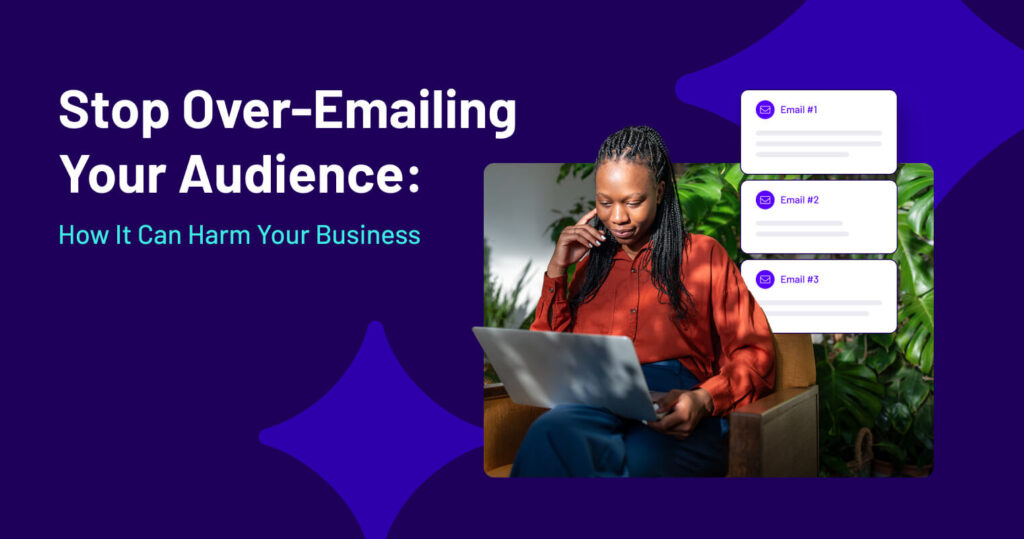
Stop Over-Emailing Your Audience: How It Can Harm Your Business
In today’s digital age, email marketing remains one of the most effective ways to reach customers and engage them with your brand. However, over-communicating with your audience can quickly turn this marketing tool into a business pitfall. Over-emailing your clients not only risks annoying them but can also lead to higher unsubscribe rates, a damaged brand image, and even a loss in revenue.
If you’re guilty of flooding inboxes, it’s time to take a step back and refine your approach. Here’s why over-emailing can hurt your business and how to target your audience better for more impactful engagement.
The Risks of Over-Emailing Your Audience
- Email Fatigue
When customers receive too many emails from your business, they may start to experience “email fatigue.” This term refers to the exhaustion and frustration that people feel when they’re bombarded with marketing messages. This often leads to them ignoring, deleting, or worse—unsubscribing from your list. Once they’ve opted out, it’s much harder to win them back. - Loss of Trust
When you send excessive emails, especially those that are not relevant or personalized, you risk eroding the trust you’ve built with your audience. If every email looks like another sales push or doesn’t add value, people will stop seeing your brand as credible. Loss of trust is costly; rebuilding it takes time, and you may lose potential sales in the process. - Increased Spam Complaints
Bombarding your customers with too many emails can lead to a higher number of spam complaints. Email service providers track spam reports, and if enough people flag your messages as unwanted, you risk having your emails automatically sent to the spam folder in the future. Worse yet, your email domain might be blacklisted, drastically lowering your chances of reaching inboxes at all. - Lower Engagement Rates
Over-emailing tends to lower your open rates and click-through rates. When your audience becomes desensitized to your messages, they will start ignoring them. Even worse, your emails could become white noise in their inbox. Lower engagement rates mean less effective campaigns, which ultimately hurts your ROI. - Loss of Revenue
If over-communication leads to your audience tuning out or unsubscribing, you’ll lose valuable opportunities to nurture leads into paying customers. When you’re no longer reaching the right audience or when trust is broken, it’s your revenue stream that suffers.
How to Better Target Your Audience
The key to email marketing success is not the quantity of emails sent but the quality of the communication. Targeting your audience with personalized, relevant content will not only keep them engaged but will also foster loyalty. Here are some effective strategies to improve your targeting:
- Segment Your Email List
One-size-fits-all emails are rarely effective. By segmenting your email list based on user demographics, behavior, and preferences, you can tailor your content to fit the specific needs of different groups. For example, segmenting by location allows you to send region-specific offers, while segmenting by purchase history enables you to recommend relevant products. - Use Lead Filtering
To avoid overwhelming your audience, use the information provided by your leads to filter them into more targeted campaigns. If a user has indicated interest in a specific product or service, focus your emails on that category. If another lead has only shown mild interest, send fewer emails or nurture them with informational content rather than hard sales pitches. Example:
If a potential client signs up for your newsletter and indicates an interest in “business software,” don’t send them generic emails about your entire product lineup. Instead, create a dedicated email campaign around business software tips, case studies, and promotions. This kind of targeting improves engagement and reduces the likelihood of email fatigue. - Track and Analyze Email Metrics
Understanding how your audience interacts with your emails is critical to optimizing your strategy. Keep a close eye on open rates, click-through rates, and unsubscribe rates. A sudden drop in engagement may indicate that you’re sending too many emails or that your content isn’t resonating. A/B testing can also help you fine-tune your messaging. - Adopt a Drip Campaign Strategy
Drip campaigns allow you to send pre-planned, automated emails to your audience at a steady pace. This ensures that your subscribers are being nurtured without being overwhelmed. Drip campaigns are particularly effective when used to guide prospects through a sales funnel, delivering the right content at the right time.
Email Marketing Tools to Help You Streamline
The right email marketing platform can make it easier to segment your list, filter leads, and track performance. Here are a few email clients that can help streamline your efforts:
- Mailchimp: Known for its user-friendly interface, Mailchimp offers robust segmentation and automation features. Its analytics provide insights into how your campaigns are performing, helping you refine your strategy.
- Constant Contact: This platform makes it easy to segment lists and create targeted campaigns. It also offers a wide variety of email templates, making it a good option for businesses that want to create professional-looking emails quickly.
- ActiveCampaign: ActiveCampaign excels at automation and lead scoring, making it perfect for businesses looking to refine their targeting. It also integrates with CRM systems, making it easier to align your email strategy with your overall sales process.
- Sendinblue: Ideal for small businesses, Sendinblue offers advanced segmentation and personalization tools. It also features SMS marketing, allowing you to diversify how you reach your audience.
Recap:
Over-emailing your audience can severely harm your business, from losing subscribers to damaging your brand’s reputation. The key to successful email marketing lies in targeted, relevant communication that adds value to your audience. By segmenting your list, filtering leads, and using the right tools to track your performance, you can deliver content that resonates with your customers without overwhelming them.
If you want to retain loyal customers and drive revenue through email marketing, take the time to tailor your approach, and stop flooding inboxes. Less can often be more when it comes to customer communication.
